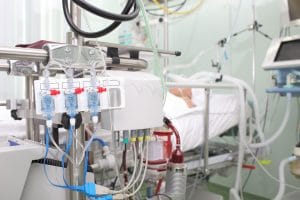By: Katelyn Corridon, PT, DPT
 I used to joke that I chose to be an acute care therapist because I loved going to work in my “pajamas”, but now when I put on my blue scrubs in the morning it feels more like a flimsy armor against invisible viral bullets. COVID-19 has changed nearly everything about daily life for millions of people around the world, including life for those of us who work in the hospital. Since finishing my acute care PT residency and beginning my job at a major academic medical center, I have been utilized as a jack-of-all-trades. I’m comfortable in nearly any setting in the hospital from CCU to wound care and therefore have found myself floating through many of the ICUs at my hospital as needed. At the beginning of the COVID-19 epidemic I found myself in the heart of the battle in the Advanced Respiratory ICU. With all of the information streaming out, it has been like trying to drink out of a firehose to become and stay informed in order to provide best and evidence-based care for my patients. The hospital, national guidelines, journals providing free and open sourced articles, even social media have been a constant deluge of COVID-19 information. New information and resources such as the APTA’s PACER project4 attempts to answer the question – How can rehab therapy best care for patients during the COVID-19 epidemic?
I used to joke that I chose to be an acute care therapist because I loved going to work in my “pajamas”, but now when I put on my blue scrubs in the morning it feels more like a flimsy armor against invisible viral bullets. COVID-19 has changed nearly everything about daily life for millions of people around the world, including life for those of us who work in the hospital. Since finishing my acute care PT residency and beginning my job at a major academic medical center, I have been utilized as a jack-of-all-trades. I’m comfortable in nearly any setting in the hospital from CCU to wound care and therefore have found myself floating through many of the ICUs at my hospital as needed. At the beginning of the COVID-19 epidemic I found myself in the heart of the battle in the Advanced Respiratory ICU. With all of the information streaming out, it has been like trying to drink out of a firehose to become and stay informed in order to provide best and evidence-based care for my patients. The hospital, national guidelines, journals providing free and open sourced articles, even social media have been a constant deluge of COVID-19 information. New information and resources such as the APTA’s PACER project4 attempts to answer the question – How can rehab therapy best care for patients during the COVID-19 epidemic?
At the beginning of the epidemic, many felt that therapists should run far away from COVID positive patients. “Why do you need to be in there?” “They’ll just recover from the virus on their own” were commonly heard. Concerns about supply chains, PPE, and spreading the virus to more  vulnerable patients were more legitimate concerns. Those concerns, to me, were still not enough to dissuade the nagging feeling that if we didn’t make it known that we were willing, capable and useful in the fight alongside our nursing, RT, APP and MD (and other) colleagues, then the PT and OT professions and, more importantly, our patients, were going to be left in the dust.
vulnerable patients were more legitimate concerns. Those concerns, to me, were still not enough to dissuade the nagging feeling that if we didn’t make it known that we were willing, capable and useful in the fight alongside our nursing, RT, APP and MD (and other) colleagues, then the PT and OT professions and, more importantly, our patients, were going to be left in the dust.
Current evidence shows that approximately 15% of individuals with COVID-19 develop moderate to severe disease requiring hospital and oxygen support, with an additional 5% requiring ICU and mechanical ventilation.1 HealthAffairs.org6 anticipates nationally that nearly 100 million individuals in the US will be affected, 20.5 million requiring hospitalization and 4.4 million will need ICU-level care. That is a huge scope of individuals that may have ICU and COVID-19 related deficits that rehab therapy can address.
So what do we know about this disease and why rehab therapy would be so important?
- COVID-19 presents with an abnormal pneumonia progressing to ARDS with severe hypoxemia despite persevered lung compliance due to ventilation/perfusion (VA/Q) mismatching. Positioning, including prone, side-lying and upright, helps improve V/Q matching and lung volumes and reduce the work of breathing. *COVID-19 does NOT present with high secretion loads requiring airway clearance but patients do benefit from respiratory muscle training and active cycle of breathing techniques.1, 2, 10, 13, 14
- Early mobility has been proven to decrease ICU length of stay, decrease time on mechanical ventilation, reduce delirium, and improve patient function and independence by discharge.7,8,9,10,15
- Early mobility and more out of bed days, in addition to sedation interruption, improves patient function and reduction of delirium.6,8,16
- Post-Intensive Care Syndrome (PICS), which encompasses ICU-Acquired Weakness (ICU-AW) as well as cognitive and emotional impacts, persists long after discharge and significantly impairs quality of life. ICU rehabilitation has been shown to reduce ICU-AW and PICS.9, 11, 12
And what have I seen to anecdotally support PT and OT involvement in COVID-19 patient care?
- A man on intubation watch for the third time starts mobilizing with therapy and quickly weans O2.
- A woman who’s oxygen status was extremely labile after completing days of proning but was able to tolerate a PT and OT co-treat and wean vent settings quickly after.
- A man who was able to self-prone during PT sessions and prevent getting intubated.
- Patients moving out of the ICU to the floor to home not nearly as weak and debilitated as expected.
- A man do fantastic on a few liters of oxygen one day to come in the next and find him intubated.
- A woman cough so hard the evening after my evaluation that she desaturated and had to be reintubated, luckily only for 12 hours.
- A man extubated after 10 days mechanically ventilated and proned with new truncal ataxia and cognitive deficits consistent with an anoxic brain injury.
- A young otherwise healthy woman who we thought would never need PT or OT end up with bilateral pneumothoraces and requiring a 14-day ICU stay and significant rehabilitation during her month-long hospitalization.
These patients are extremely fragile, medically labile, and incredibly complex. The COVID-19 ARDS picture is very unstable and the statistics of “older and unhealthy” patients being the most vulnerable is not always true clinically, although there are plenty of those as well. Rehab therapy is not needed in every room. But we are needed for a many of these patients at some point of their admission. Critical thinking, collaboration, and creativity are necessary for appropriate management of these patients within the current pandemic.
Tools that can be utilized:
- Excellent chart review – with medical fragility and no family at bedside, this is crucial.
- Creativity – likely there will be little equipment you can utilize and being confined to the room can be difficult, creativity is a must!
- Trust your judgement – patients change very rapidly and even the nurse may not have the most recent information.
- Take your shot – if a patient is awake, alert, able to follow commands, is hemodynamically stable and has a stable airway, it’s probably the best time you’re going to get to be in the room. Don’t talk yourself out of a good opportunity to try something to help someone mobilize. It may be the chance they need to open up their lung fields or offload for skin integrity or have cognitive input to prevent delirium or be reminded to move their limbs to prevent weakness. Vents are your friend, sedation and neuromuscular blockade is not. The vent provides the patient with respiratory support. If you are not comfortable with mobilizing patients who are intubated, work with a teammate, RN or RT who is!
- Be part of the team- Check your ego at the door and help with what needs to be done, especially when utilizing a set of PPE*. Changing sheets while a patient is rolling or transferring out of bed may make your nurse’s day! Join the team you’re working with and do whatever you can in your scope to support your team and your patients.
*Side note, this may all vary per hospital setting and policy. If you are not comfortable with the PPE that is provided for you or it is not adequate for your protection, no patient’s mobility is worth more than your life and safety.
The most joyful experiences to come out of this pandemic have been from spending time in the room with my patient. In addition to mobility, exercise, breathing techniques, and many toileting opportunities (much to the joy of my OT colleagues), I have held patient’s hands while they’ve cried, held cellphones up for hands too weak to hold them for long to FaceTime family, and prayed with patients for healing. I try and take my time in these rooms since I’m already “gowned up” and in all of this extra time. I have always managed to learn something new that I didn’t expect, such as a family member that may be able to help with ADLs or a goal of returning to gardening. Things I may not ever have learned before because of the in-and-out nature of my job. By being dedicated to these patients, I’m leaning about them and myself. I’m a part of a team that’s helping heal them, whether it be to jump in line for CPR (I’m ACLS certified and firmly believe that if you work in the ICU, codes and emergencies are part of your job description as a team member) or change bedsheets.
Despite all that I have learned, researched and experience through the beginning of this pandemic, acute care therapy can still be broken down into three major components – 1. Take vital signs, 2. Get people moving, 3. Don’t pull anything out.
Resources are abundant. These links and articles I have found to be the most thorough and helpful!
- Respiratory Management of COVID-19, Physiopedia. https://physio-pedia.com/Respiratory_Management_of_COVID_19
- Physiotherapy Management for COVID-19 in the Acute Hospital Setting: Recommendations to Guide Clinical Practice. Version 1. 23 March 2020. https://www.journals.elsevier.com/journal-of-physiotherapy
- APTA COVID-19 Resources for the Physical Therapy Profession. http://www.apta.org/coronavirus/
- APTA PACER Project https://learningcenter.apta.org/student/mycourse.aspx?id=f4b7ebc7-bdbd-4808-814c-c875c8aee805
- AOTA COVID-19 & OT. https://www.aota.org/Conference-Events/Coronavirus-COVID19.aspx
Other References:
- “American Hospital Capacity and Projected Need for COVID-19 Patient Care,” Health Affairs Blog. March 17, 2020. DOI: 10.1377/hblog20200317.457910
- Alvarez EA, Garrido MA, Tobar EA, et al. Occupational therapy for delirium management in elderly patients without mechanical ventilation in an intensive care unit: A pilot randomized clinical trial. J Crit Care. 2017;37:85-90.
- Balas MC, Vasilevskis EE, Olsen KM, et al. Effectiveness and safety of the awakening and breathing coordination, delirium monitoring/management, and early exercise/mobility bundle. Crit Care Med. 2014;42(5):1024-1036.
- Batt J, dos Santos CC, Cameron JI, Herridge MS. Intensive care unit-acquired weakness: clinical phenotypes and molecular mechanisms. Am J Respir Crit Care Med. 2013;187(3):238-246.
- Brown SM, Wilson E, Presson AP, et al. Predictors of 6-month health utility outcomes in survivors of acute respiratory distress syndrome. 2017;72(4):311-317.
- Brown SM, Wilson EL, Presson AP, et al. Understanding patient outcomes after acute respiratory distress syndrome: identifying subtypes of physical, cognitive and mental health outcomes. 2017;72(12):1094-1103.
- Fuke R, Hifumi T, Kondo Y, et al. Early rehabilitation to prevent postintensive care syndrome in patients with critical illness: a systematic review and meta-analysis. BMJ Open 2018;8:doi: 10.1136/bmjopen-2017-019998
- Gattinoni, L., Chiumello, D. & Rossi, S. COVID-19 pneumonia: ARDS or not?. Crit Care24, 154 (2020). https://doi.org/10.1186/s13054-020-02880-z
- Guerin C, Reignier J, Richard JC, et al. Prone positioning in severe acute respiratory distress syndrome. N Engl J Med. 2013;368(23):2159-2168.
- Nydahl P, Sricharoenchai T, Chandra S, et al. Safety of Patient Mobilization and Rehabilitation in the Intensive Care Unit. Systematic Review with Meta-Analysis. Ann Am Thorac Soc. 2017;14(5):766-777.
- Perme C, Chandrashekar R. Early Mobility and Walking Program for Patients in Intensive Care Units: Creating a Standard of Care. American Journal of Critical Care. 2009;18(3)212-221. doi:10.4037/ajcc2009598.


